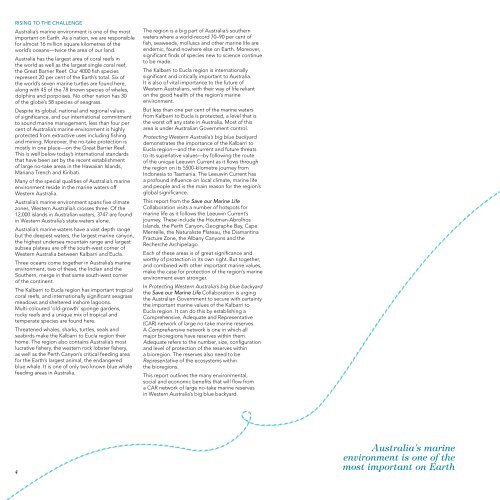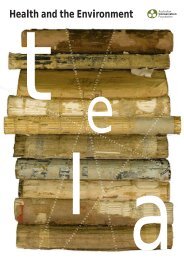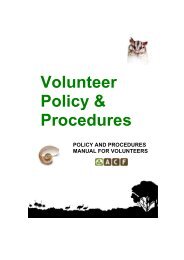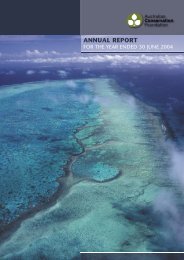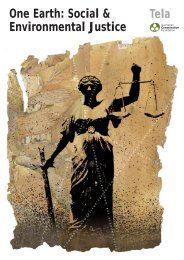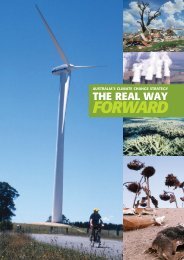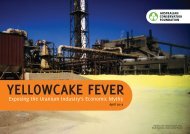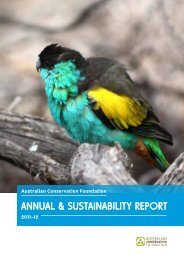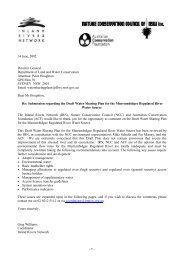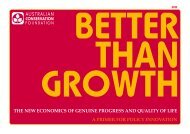Protecting Western Australia's Big Blue Backyard - The Pew ...
Protecting Western Australia's Big Blue Backyard - The Pew ...
Protecting Western Australia's Big Blue Backyard - The Pew ...
- No tags were found...
Create successful ePaper yourself
Turn your PDF publications into a flip-book with our unique Google optimized e-Paper software.
RISING TO THE CHALLENGEAustralia’s marine environment is one of the mostimportant on Earth. As a nation, we are responsiblefor almost 16 million square kilometres of theworld’s oceans—twice the area of our land.Australia has the largest area of coral reefs inthe world as well as the largest single coral reef,the Great Barrier Reef. Our 4000 fish speciesrepresent 20 per cent of the Earth’s total. Six ofthe world’s seven marine turtles are found here,along with 45 of the 78 known species of whales,dolphins and porpoises. No other nation has 30of the globe’s 58 species of seagrass.Despite its global, national and regional valuesof significance, and our international commitmentto sound marine management, less than four percent of Australia’s marine environment is highlyprotected from extractive uses including fishingand mining. Moreover, the no-take protection ismostly in one place—on the Great Barrier Reef.This is well below today’s international standardsthat have been set by the recent establishmentof large no-take areas in the Hawaiian Islands,Mariana Trench and Kiribati.Many of the special qualities of Australia’s marineenvironment reside in the marine waters off<strong>Western</strong> Australia.Australia’s marine environment spans five climatezones, <strong>Western</strong> Australia’s crosses three. Of the12,000 islands in Australian waters, 3747 are foundin <strong>Western</strong> Australia’s state waters alone.Australia’s marine waters have a vast depth rangebut the deepest waters, the largest marine canyon,the highest undersea mountain range and largestsubsea plateau are off the south-west corner of<strong>Western</strong> Australia between Kalbarri and Eucla.Three oceans come together in Australia’s marineenvironment, two of these, the Indian and theSouthern, merge in that same south-west cornerof the continent.<strong>The</strong> Kalbarri to Eucla region has important tropicalcoral reefs, and internationally significant seagrassmeadows and sheltered inshore lagoons.Multi-coloured ‘old-growth’ sponge gardens,rocky reefs and a unique mix of tropical andtemperate species are found here.Threatened whales, sharks, turtles, seals andseabirds make the Kalbarri to Eucla region theirhome. <strong>The</strong> region also contains Australia’s mostlucrative fishery, the western rock lobster fishery,as well as the Perth Canyon’s critical feeding areafor the Earth’s largest animal, the endangeredblue whale. It is one of only two known blue whalefeeding areas in Australia.<strong>The</strong> region is a big part of Australia’s southernwaters where a world-record 70–90 per cent offish, seaweeds, molluscs and other marine life areendemic, found nowhere else on Earth. Moreover,significant finds of species new to science continueto be made.<strong>The</strong> Kalbarri to Eucla region is internationallysignificant and critically important to Australia.It is also of vital importance to the future of<strong>Western</strong> Australians, with their way of life relianton the good health of the region’s marineenvironment.But less than one per cent of the marine watersfrom Kalbarri to Eucla is protected, a level that isthe worst off any state in Australia. Most of thisarea is under Australian Government control.<strong>Protecting</strong> <strong>Western</strong> Australia’s big blue backyarddemonstrates the importance of the Kalbarri toEucla region—and the current and future threatsto its superlative values—by following the routeof the unique Leeuwin Current as it flows throughthe region on its 5500-kilometre journey fromIndonesia to Tasmania. <strong>The</strong> Leeuwin Current hasa profound influence on local climate, marine lifeand people and is the main reason for the region’sglobal significance.This report from the Save our Marine LifeCollaboration visits a number of hotspots formarine life as it follows the Leeuwin Current’sjourney. <strong>The</strong>se include the Houtman-AbrolhosIslands, the Perth Canyon, Geographe Bay, CapeMentelle, the Naturaliste Plateau, the DiamantinaFracture Zone, the Albany Canyons and theRecherche Archipelago.Each of these areas is of great significance andworthy of protection in its own right. But together,and combined with other important marine values,make the case for protection of the region’s marineenvironment even stronger.In <strong>Protecting</strong> <strong>Western</strong> Australia’s big blue backyardthe Save our Marine Life Collaboration is urgingthe Australian Government to secure with certaintythe important marine values of the Kalbarri toEucla region. It can do this by establishing aComprehensive, Adequate and Representative(CAR) network of large no-take marine reserves.A Comprehensive network is one in which allmajor bioregions have reserves within them.Adequate refers to the number, size, configurationand level of protection of the reserves withina bioregion. <strong>The</strong> reserves also need to beRepresentative of the ecosystems withinthe bioregions.This report outlines the many environmental,social and economic benefits that will flow froma CAR network of large no-take marine reservesin <strong>Western</strong> Australia’s big blue backyard.4Australia’s marineenvironment is one of themost important on EarthThreatened southern right whales areslowly recovering from whaling. A motherand her calf bask in south-coast waterswarmed by the Leeuwin CurrentAndrew Halsall Photography / © DEWHA


